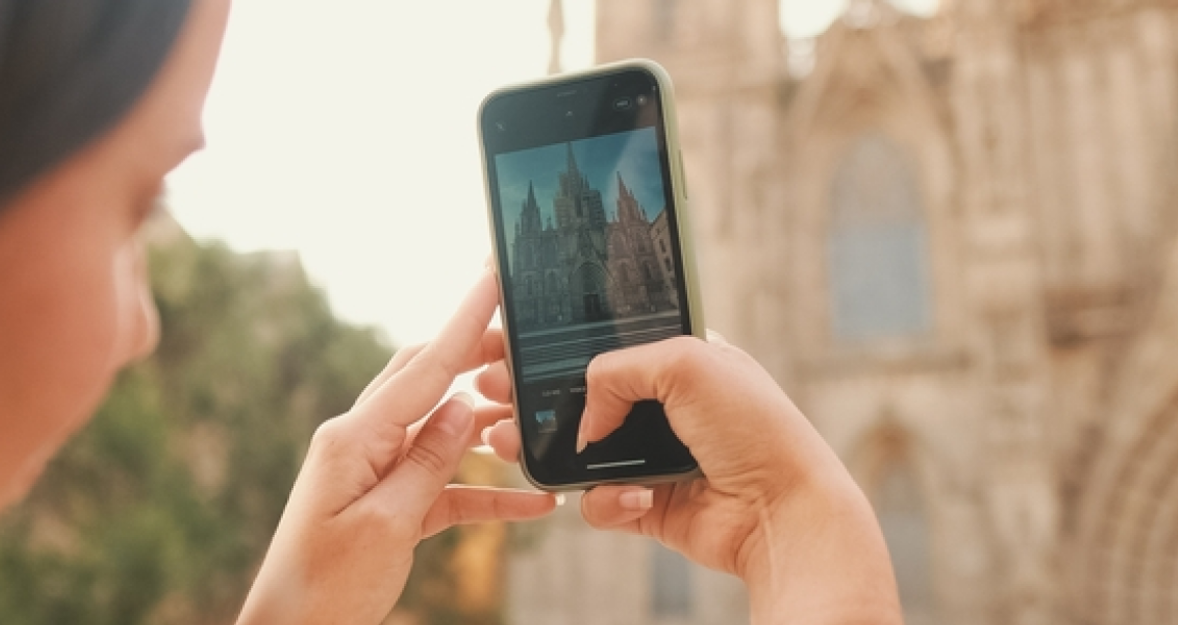August 18
12 min. to read
How To Enhance Photos On iPhone: Optimize Your Shots
If you’ve ever looked at your iPhone photos and thought, “This could look sharper or brighter,” you’re not alone. iPhones take fantastic shots right out of the box, but a few tweaks can push them from “good” to “wow.” Whether you’re snapping everyday memories or Instagram-worthy landscapes, small changes in how you shoot and edit usually make a big difference. In this guide, we’ll explore practical ways to get clearer, richer, and more vibrant shots—with no need for professional photography skills.
1. Start With the Best Possible Capture
 Enhancing a photo begins before you even press the shutter. The sharper and cleaner your original shot, the better your editing results will be.
Enhancing a photo begins before you even press the shutter. The sharper and cleaner your original shot, the better your editing results will be.
Use Natural Light Whenever Possible
Artificial lighting can sometimes create color casts or shadows. Position your subject near a window or head outdoors for even, soft lighting. Overcast days typically give you beautiful diffused light.
Keep Your Lens Clean
Fingerprints and dust can make your images look hazy. A quick wipe with a microfiber cloth will instantly boost clarity.
Avoid Digital Zoom
If you need a closer shot, physically move closer instead of pinching to zoom. Digital zoom can reduce detail and make your photo grainy.
2. Adjust Camera Settings for Higher Quality
 Your iPhone already has settings that can help you get sharper, more detailed images before editing.
Your iPhone already has settings that can help you get sharper, more detailed images before editing.
Setting | Where to Find It | Why It Helps |
HDR (High Dynamic Range) | Camera app → HDR icon | Balances bright and dark areas for more detail. |
48MP (iPhone 14 Pro and newer) | Settings → Camera → Formats | Captures higher resolution for more editing flexibility. |
RAW Capture | Camera app → RAW button | Saves maximum detail for advanced edits. |
If you’re wondering how to enhance photo quality on iPhone, enabling these settings is the easiest place to start.
3. Use Composition Tricks
 Even with perfect lighting and resolution, composition can make or break a shot.
Even with perfect lighting and resolution, composition can make or break a shot.
The Rule of Thirds
Turn on the grid in Settings → Camera → Grid. Place your subject along these lines or intersections for balanced, pleasing images.
Leading Lines
Use roads, fences, or shadows to guide the viewer’s eyes toward your subject.
Negative Space
Sometimes less is more. Leaving empty space around your subject can make it stand out more.
4. Edit Smartly With Built-In Tools
 Apple’s Photos app has surprisingly powerful editing features that many people overlook.
Apple’s Photos app has surprisingly powerful editing features that many people overlook.
Brightness & Exposure – Lighten dark areas without blowing out highlights.
Contrast – Adds depth by making darks darker and lights lighter.
Sharpness & Definition – Make textures pop without making the image look artificial.
Vibrance – Boosts muted colors without oversaturating the whole image.
If you’re figuring out how to increase photo quality on iPhone, start by exploring these sliders instead of jumping straight to third-party apps.
5. Enhance With AI Tools
 While Apple’s editor is excellent, with powerful tools, you can make your images even better. An image quality enhancer will automatically restore details, balance exposure, and enhance colors, saving you time and effort. Such tools use AI to detect the subject, background, and lighting conditions, and then apply specialized adjustments. This means less trial and error and more instantaneous results.
While Apple’s editor is excellent, with powerful tools, you can make your images even better. An image quality enhancer will automatically restore details, balance exposure, and enhance colors, saving you time and effort. Such tools use AI to detect the subject, background, and lighting conditions, and then apply specialized adjustments. This means less trial and error and more instantaneous results.
6. Fix Blurry Shots Quickly
 Sometimes, no matter how careful you are, a picture ends up slightly out of focus. Instead of deleting it, try software designed to make photo unblurry. It can sharpen edges, restore fine details, and even reduce motion blur caused by shaky hands. This is especially useful for action shots or dimly lit scenes.
Sometimes, no matter how careful you are, a picture ends up slightly out of focus. Instead of deleting it, try software designed to make photo unblurry. It can sharpen edges, restore fine details, and even reduce motion blur caused by shaky hands. This is especially useful for action shots or dimly lit scenes.
7. Improve Resolution Without Losing Quality
 If you need to print or crop an image, resolution matters. For those wondering how to improve resolution of a photo on iPhone, the trick is to upscale it without making it pixelated. Third-party AI-powered apps intelligently add missing pixels, preserving sharpness. This is far better than simply enlarging the image in Photos, which can lead to fuzziness.
If you need to print or crop an image, resolution matters. For those wondering how to improve resolution of a photo on iPhone, the trick is to upscale it without making it pixelated. Third-party AI-powered apps intelligently add missing pixels, preserving sharpness. This is far better than simply enlarging the image in Photos, which can lead to fuzziness.
8. Explore Creative Editing Options
 Enhancing isn’t always about making something look realistic—it may also mean making it stand out in unique ways. For example, if you’ve ever wondered how to invert photo on iPhone, it’s surprisingly easy and can create surreal, eye-catching effects for social media or creative projects.
Enhancing isn’t always about making something look realistic—it may also mean making it stand out in unique ways. For example, if you’ve ever wondered how to invert photo on iPhone, it’s surprisingly easy and can create surreal, eye-catching effects for social media or creative projects.
Other creative tweaks include:
Applying selective color to highlight a single hue.
Blurring backgrounds for a portrait effect.
Adding vignettes to draw focus to the center.
9. Master Low-Light and Night Photography
 Low-light images are notoriously tricky, but your iPhone has tools to make them shine.
Low-light images are notoriously tricky, but your iPhone has tools to make them shine.
Use Night Mode
Night Mode automatically activates in dark settings. Keep your phone steady for the duration of the capture for best results.
Shoot RAW in the Dark
RAW files retain more shadow detail, which you can brighten later without introducing noise. If you’re passionate about astrophotography, check out tips on how to take photos of stars on iPhone to capture stunning night skies.
10. Edit Like a Pro on the Go
 If you want more control than the Photos app offers, you can explore iPhone photo editing apps. They give you access to advanced tools like selective edits, layers, and custom filters. Some even sync with desktop software, so you start editing on your iPhone and finish on your computer without losing progress.
If you want more control than the Photos app offers, you can explore iPhone photo editing apps. They give you access to advanced tools like selective edits, layers, and custom filters. Some even sync with desktop software, so you start editing on your iPhone and finish on your computer without losing progress.
11. Save Your Photos in the Highest Quality
 You can take the best shot in the world, but if it’s saved in a compressed format, it will lose quality. To how to make pictures better quality on iPhone, save them in HEIF or RAW instead of JPEG when possible.
You can take the best shot in the world, but if it’s saved in a compressed format, it will lose quality. To how to make pictures better quality on iPhone, save them in HEIF or RAW instead of JPEG when possible.
In Settings → Camera → Formats, choose “High Efficiency” for HEIF or enable RAW capture for maximum detail. This way, even after editing and sharing, your images retain more information.
Quick Checklist for Better iPhone Photos
 Here’s a quick rundown of habits that will instantly make your shots better. Consider it your cheat sheet prior to, during, and post-picture-taking.
Here’s a quick rundown of habits that will instantly make your shots better. Consider it your cheat sheet prior to, during, and post-picture-taking.
Before Shooting
Clean the lens – Even a small fingerprint can cause blur or haze. Use a soft microfiber cloth, not your shirt, to avoid scratches.
Use natural light – Position yourself so light falls evenly on your subject. Morning and late afternoon often give the most flattering results.
Avoid digital zoom – Instead of pinching in, move physically closer or crop later. This keeps your images sharper and more detailed.
While Shooting
Enable HDR – This helps balance bright skies and dark shadows, especially in landscapes.
Use the grid for composition – Turn on the grid to apply the rule of thirds or keep horizons straight.
Hold steady, especially in low light – Brace your elbows against your body or use a surface/tripod to avoid motion blur.
After Shooting
Adjust exposure, contrast, and sharpness – Small, careful tweaks can make your photo pop without looking over-edited.
Use AI tools for advanced enhancement – These will recover hidden details, fix lighting, or sharpen slightly blurry shots in seconds.
Save in the highest quality possible – Choose HEIF or RAW formats to keep more detail for printing or large displays.
What It All Means
Your iPhone is already a pretty incredible camera—always in your pocket, ready to capture anything from a quick coffee shot to a once-in-a-lifetime sunset. But turning a decent picture into one that really stands out usually comes down to a few small, deliberate choices—and knowing how to improve picture quality on iPhone can make all the difference.
Pay attention to the light. Play around with your camera settings. And don’t be afraid to add a little editing magic afterward. Sometimes, something as simple as wiping the lens clean or holding the phone a bit steadier will make a surprisingly big difference.
The sharper and better your original photo, the less work you’ll have to do later. From there, small enhancements—tweaking brightness, bringing out details, or improving resolution—can help your images truly shine.


 >
>

